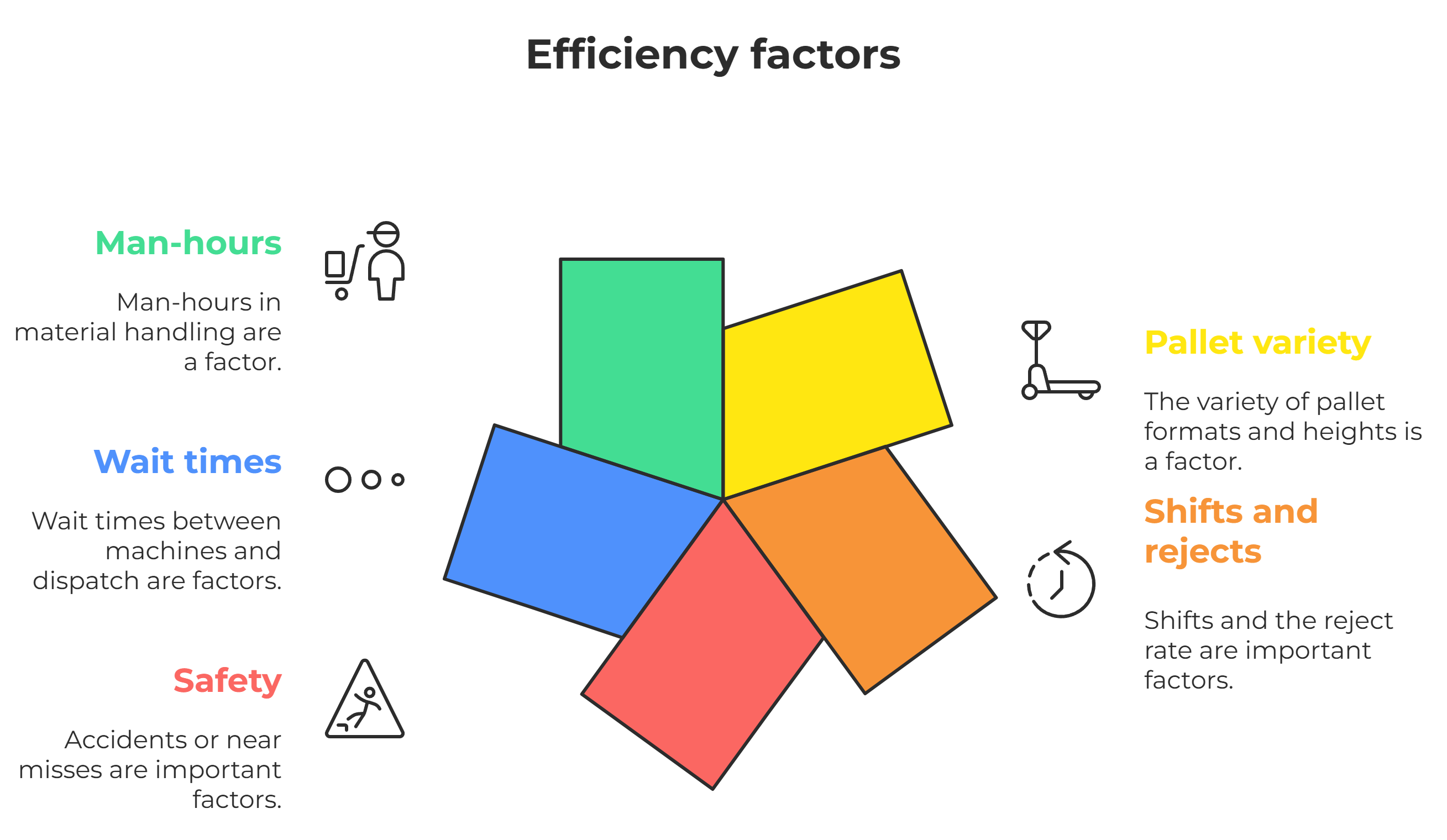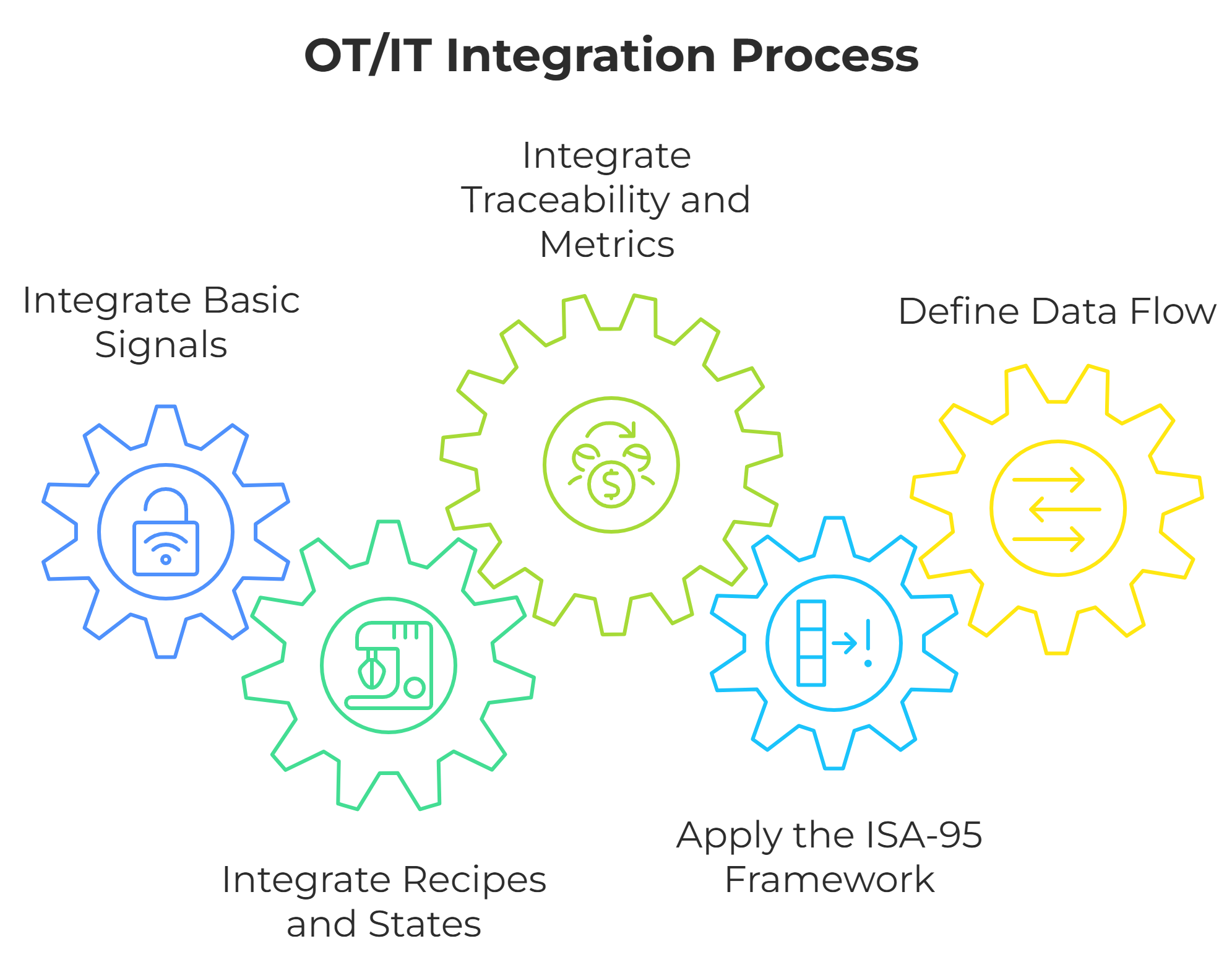
Automatic Palletizing in Precast
A guide to implement without stopping the plant and with a verifiable ROI
If you run blocks, pavers, or precast, the end of line concentrates risks, hidden costs, and bottlenecks. Automatic palletizing cuts manual handling, stabilizes flow, and improves safety without long stoppages.
At CBM Experts we help you automate while keeping production running: we analyze your mix of formats, plan buffers, and size the end-of-line layout design so the change is controlled, measurable, and with a proven return.
Automation also helps mitigate ergonomic risks from manual handling as set out in EU Directive 90/269/EEC.
Assess the format mix, shifts, reject rate, bottlenecks, and ergonomic risks before deciding. If you need a guide to align the technical decision with ROI, see our article on how to choose machinery for concrete blocks.
Automatic Palletizing in Precast
A guide to implement without stopping the plant and with a verifiable ROI
Starting point: when automatic palletizing is the right lever
Palletizing systems: architectures that fit your real end of line
Palletizing robot vs. Cartesian gantry: selection criteria by product and space
Buffers and operational “lung”: absorb peaks without slowing production
Machine vision for palletizing: precision and control in dusty environments
End-of-line layout design: flows, safety, and access that work
Coexisting with the current layout: bypass, preassembly, and minimal relocations
Implementation without stopping the plant: low-risk phased method
Functional safety and compliance: automatic palletizing without incidents
Automatic palletizing ROI: how to calculate it without optimistic bias
Payback and IRR by scenarios: 1, 2, and 3 shifts with a changing mix
Total Cost of Ownership (TCO): energy, spares, SLA, and training
Prerequisites and implementation checklist: get it right first time
Post-start KPIs: stabilize the cell and sustain improvement
Typical cases by buyer role: how the project maps to each objective
Specific FAQs that pre-empt real objections
How do we finance an automatic palletizing system with no upfront CAPEX?
What do ISO 9001/14001/45001 audits require during implementation?
How do we design a 2-week PoC pilot to validate the business case?
What pallet labeling and coding standard should we apply for traceability?
Impact on insurance: fire load and prevention in the palletizing area?
Conclusion: automatic palletizing with continuity and return guaranteed
Starting point: when automatic palletizing is the right lever
Before talking robots or palletizing systems, check the basics:
Variety of formats and pallet heights.
Shifts, reject rate.
Accidents or near-misses.
Wait times between machines and shipping.
Person-hours in handling.
If you see peak season spikes, frequent recipe changes, or tight end-of-line space, automation is usually the lever with the best impact/risk ratio. The target is clear: continuity, stable quality, and lower operator exposure to repetitive, strenuous tasks.

Palletizing systems: architectures that fit your real end of line
There are compact cells and scalable lines. In precast these blocks work well:
Palletizing robot cell (articulated or gantry).
Buffers to decouple rates and peripherals (conveyors, stretch wrapping, edge protectors, labeling).
The right fit depends on weights, dimensions, product stability, and shipping requirements. The key is not “more automation” but the right amount for your main constraint.
Palletizing robot vs. Cartesian gantry: selection criteria by product and space
An articulated robot offers flexibility for format changes and a smaller footprint. A Cartesian gantry excels with heavy loads, repetitive patterns, and very dusty environments with defined paths.
Evaluate reach, payload, gripper types, ease of maintenance, guarding needs, and cycle times.
If you often change layer patterns or height
Buffers and operational “lung”: absorb peaks without slowing production
A good buffer prevents micro-stops in palletizing from halting the line. Size it using three inputs:
Production takt time.
Upstream variability.
Shipping windows.
Calculate how many minutes of accumulation you need and place buffer where it best smooths bottlenecks. Too much buffer adds cost and floor area. Too little triggers cascading stops. Tune with real data and simulate peak scenarios.
Machine vision for palletizing: precision and control in dusty environments
Machine vision handles position/orientation ID and dimensional control. In precast, dust demands protected optics, auto-cleaning, and proper lighting. Combine 2D for presence/position and 3D when you need height or deformation measurement.
A solid system rejects out-of-tolerance pieces and traces them by lot, improving quality and cutting rework.
Well-calibrated machine vision reduces out-of-tolerance rejects and stabilizes batch quality. If you want a clear list of variables that affect the final product, review the quality factors for concrete blocks.
End-of-line layout design: flows, safety, and access that work
End-of-line layout must prioritize unidirectional flow, safe forklift aisles, turning radii, maintenance access, and guarding without “dead corners.”
With tight floor space, use compact islands, walkways for intervention, and separate routes for people and forklifts. Rule of thumb: fewer crossings and fewer maneuvers mean more throughput and fewer incidents.
Coexisting with the current layout: bypass, preassembly, and minimal relocations
To implement without stopping, complete civil works, anchors, cabling, and tests in “shadow mode.” Design a temporary bypass to keep shipping, embed fixing points, and preassemble outside the live area. Plan short, announced cuts with milestone checklists and clear acceptance criteria.
Integrate in phases: first basic signals with PLC and safety, then recipes and states, finally traceability and production metrics.
Integrate in phases: first basic signals with PLC and safety, then recipes and states, finally traceability and production metrics.
Working within ISA-95 (IEC 62264) streamlines the plant-to-business data model, speeds MES/ERP connection, and reduces integration rework.
At CBM Experts we apply it to define what data goes up, how often, and at what quality.

Implementation without stopping the plant: low-risk phased method
Structure the project into FAT in the shop, preassembly, SAT, and stabilization. Chain weekends and short downtime windows to “cut” the line and switch over to the new system.
Define roles per shift, short repeated training, and “shadow mode” with the system observing before the real start. Stage-gate releases reduce surprises and bound risk.
If you want the full framework to coordinate civil works, production, and commissioning, read our article on how to modernize your concrete block plant without stopping production.
Functional safety and compliance: automatic palletizing without incidents
The cell must meet a risk assessment and the right safety levels. ISO 13849-1 guides the design of safety-related control parts and how to justify the Performance Level of functions like E-stop, interlocks, or laser scanners.
Demand documented validation and testing before handover.
Automatic palletizing ROI: how to calculate it without optimistic bias
ROI is not just person-hours. Include scrap and damage reduction, ergonomics and incident improvement, lower quality variability, optimized consumables (film, edge protectors), and higher delivery reliability.
Assess impact on lead time and use conservative depreciation. Work with ranges and scenarios, not a single number.
Payback and IRR by scenarios: 1, 2, and 3 shifts with a changing mix
Model three scenarios of availability, peak demand, and reject rate.
In 1 shift, savings come mainly from ergonomics and quality.
In 2–3 shifts, continuity and rate matter more.
Sensitivity-test IRR with 5–10% changes in availability, energy, and maintenance to find the real needle-mover.
Total Cost of Ownership (TCO): energy, spares, SLA, and training
Sign contracts that cover estimated energy per cycle, 12-month critical kits, response and replacement times, and new-operator training.
An SLA with availability metrics and clear penalties prevents surprise costs. Consider spare grippers, gearboxes, bearings, sensors, and vision components.
Prerequisites and implementation checklist: get it right first time
Confirm electrical power and compressed air, floor stability and vibration, clear height and anchor points. Plan dust cleaning, climate-controlled enclosures if temperature fluctuates, and robust connectivity for integration.
Define from the start who operates, who maintains, and how recipe changes are managed.
Post-start KPIs: stabilize the cell and sustain improvement
Track hourly production rate, OEE, reject rate by cause, critical alarms, MTBF/MTTR, and ergonomic metrics. Review weekly at first, then monthly, with thresholds that trigger maintenance, training, or recipe adjustments.
Document lessons and lock the configuration when you reach stability.
Typical cases by buyer role: how the project maps to each objective
Plant Manager: continuity and safety. You want a safe, accessible, easy-to-maintain cell. Ask for a layout with clear access and guarding and simple operational KPIs.
Operations: productivity and flow. You want well-sized buffers and quick recipe changes. Request prior simulation and tests with your formats.
Maintenance: reliability and spares. Demand critical-parts lists, clear manuals, and diagnostics training.
Purchasing: TCO and SLA. Value proposals with the full cost curve and firm response and availability guarantees.

Specific FAQs that pre-empt real objections
How do we finance an automatic palletizing system with no upfront CAPEX?
Consider pay-per-use or leasing. Compare project IRR with cost of capital and review availability and maintenance clauses.
What do ISO 9001/14001/45001 audits require during implementation?
Evidence of change control, waste management, risks, and training. Prepare records by phase and a documentation owner.
How do we design a 2-week PoC pilot to validate the business case?
Set measurable goals, a format dataset, go/no-go success criteria, and a scale-up plan if the threshold is met.
What pallet labeling and coding standard should we apply for traceability?
Use SSCC as the unique logistics unit ID and labeling per the GS1 Logistic Label guideline to integrate with partners and ERP/MES.
Impact on insurance: fire load and prevention in the palletizing area?
Coordinate with your insurer. Provide risk analysis, protection measures, cleaning plans, and maintenance records.
Conclusion: automatic palletizing with continuity and return guaranteed
Automating the end of line without stopping the plant is viable if you act on three levers:
Smart layout that minimizes crossings.
Data-sized buffers.
Reliable vision that preserves quality.
Add staged integration under ISA-95 and validate safety per ISO 13849-1. At CBM Experts we can assess your case with real data and build a roadmap that delivers measurable results from the first milestone.
If you want to prioritize investments with maximum impact and minimal downtime:
👉 Fill out our form for an initial technical assessment.
👉 Request a quote and a phased plan from CBM Experts to optimize your end of line without stopping the plant.

